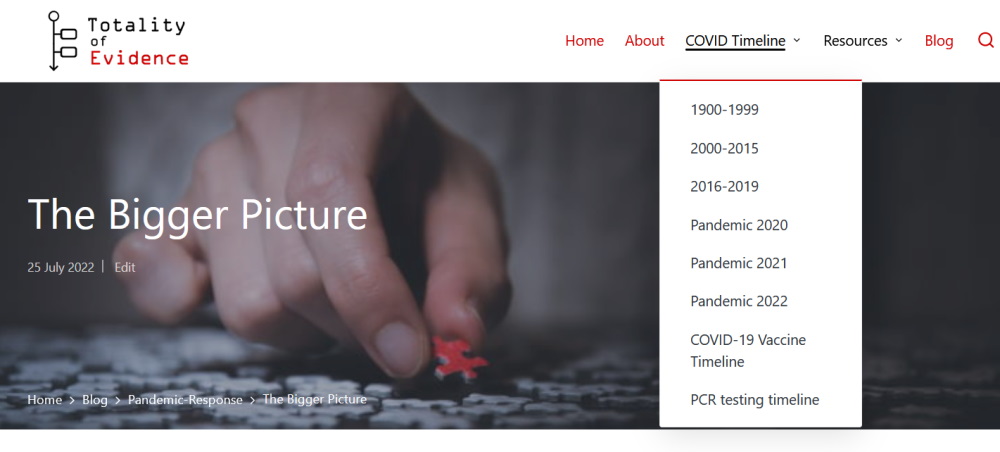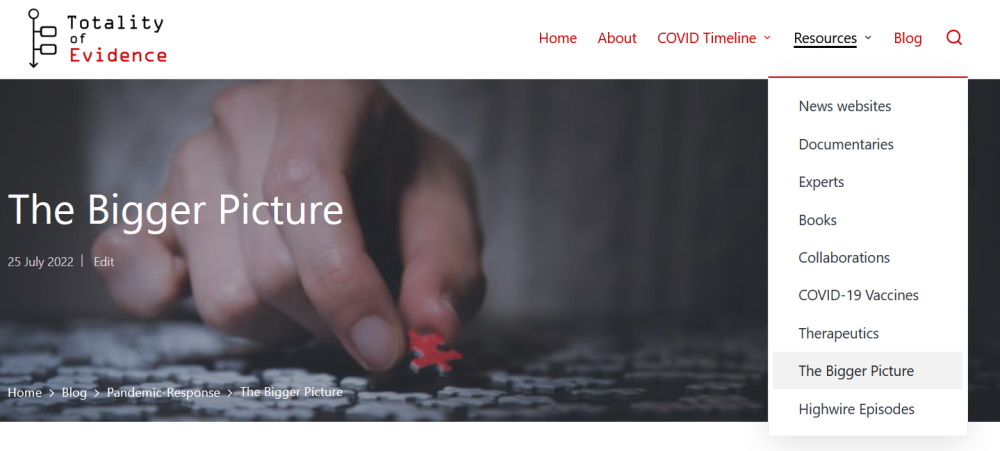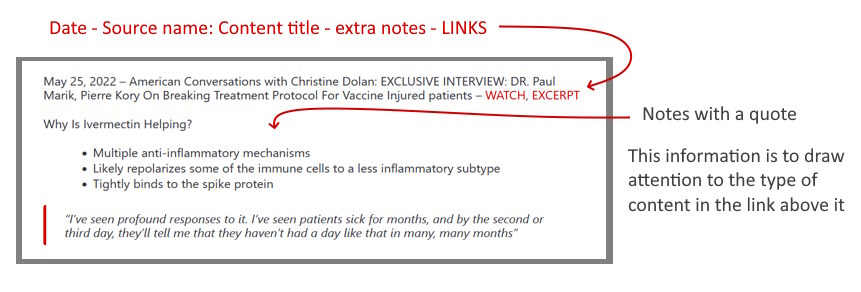How to use Totality of Evidence (ToE)
ToE is a resource website to help you do your own research.
You will NOT find many articles written by @JustCallMeJack here, just pages with summary introductions to pandemic related topics under which I collate, often in reverse chronological order, “data points” relating to that specific or broad page topic.
You will find both Resource pages and Timeline Pages. Timeline pages hone in on a specific event in time where as resource topics capture broader infomation on that topic.
How resource topic pages are set out:
I’ve tried to set out each topic-page in a similar format. Starting with an introduction, to provide an overview of maybe a credentialed expert or a COVID-19 vaccine related topic. Following that introduction, which often includes links to official websites or other related pages, I then begin collecting interviews and articles, which I call “data points”, in publishing these in reverse chronological order.
Earlier posts, especially on therapeutics were created prior to this format, which I likely will not get time to update. Be sure to scroll down to find the content in this newer format.
ToE is a work-in-progress and many pages are continuously being added to, with many more topics to come – if time permits.
If you find value in my work, and want to help me continue this work, your support would be welcome.
Capturing a historical, time capsule of events
leading up to and through the COVID-19 pandemic,
both as a timeline and by pandemic or big-picture topic
Dates most often relate to Australian time zone
Be aware that dates are added, most often, for an Australian time zone, so they maybe ahead by 12-24 hours. I’ve tried, where possible, to document the date relative to the time-zone where the content was created, or if the content creator stipulates the date, but most often this is not easy to do. News websites and blogs often auto correct dates/time to reflect the time zone of the reader, which is the date that I enter.
The Menu Tabs
COVID-19 Timeline
The COVID-19 pandemic timeline is a growing body of work, that still has many data points that need to be added. It takes time to research each data point and find links, where I can, to original source material. It likely will never be complete, but there already is enough to reveal the mission-creep!
When you hear people say “do your own research“, this site has much of the hard work already done for you, by linking you to the sources. Your job is to read the content, search for more and make up your own mind.
The COVID-19 Timeline is best viewed on a large screen. All links should open in a new tab and because of the growing length of the content it takes a few moments for each page to fully load. Sometimes the “month” hyperlinks won’t work because the pages are too long, and that month you want to jump to is on the next section to be loaded as you scroll down. This function doesn’t seem to work very well on a mobile phone.

Resources categories
The Resource section is an attempt to organise content in a logical manner, and make it quick and easy to find topics. These are the broad topics covered:
- News Websites – not the mainstream
- Documentaries
- Credentialed Experts – counter-narrative experts
- Books – reading list
- Collaborations of groups and organisations
- COVID-19 vaccines related topics
- Therapeutics – both the early treatments and the new “patented” anti-virals
- Public Health – Topics that don’t fit “vaccines”
- The Bigger Picture – topics to help flesh out what’s going on!
- Highwire Episodes – past episodes listed by date and title (a news time capsule)

The “Blog”
The blog section, for lack of a better word, is not a typical web-log of articles, most rather reveals when newly added topic pages are added. Post dates are basically irrelevant.
Data point format
Data point content added to each page is generally formatted in this following way:
Date – Source Name: Title of the content – sub-title – LINK
Bullet point notes underneath

Referenced to scientific papers are also formatted the same as above for consistency, even though it is technically not the correct bibliography format. I often present the title of the paper in italics to help distinguish from other article content.
I try to watch and read as much of the content I can and sometimes add a note or a quote below the reference, this will be separated from the previous link with a separator line, like the one below, this makes it clear that the content is related to the link above it so you know where to check it out for yourself.
I’ve listed content by date but in reverse chronological order, this is done for two reasons:
- I am constantly adding content that comes to my attention, so adding to the top of the page saves my precious time!
- The visitor can see the latest news first (assuming I’ve kept up with content, no guarantee!).
I try to add everything relevant that passes my attention, to capture the historical timeline of events – but realistically there is way too much for one person to capture everything. Interviews that I feel are pivotal or comprehensive Ioften make the date bold and/or highlight certain words to draw attention.
Scroll to the bottom of a page to find interviews that first brought a particular “expert” to public attention. This may be time consuming on a phone, so try to view on a larger screen.
If you are time poor:
- Look for entries that have their date in bold, or
- Look for listings with a gray background:
Around August 2022 I started to highlight, with a gray background, content that I felt was comprehensive, pivotal or a must watch/listen interview. Some pages are very busy and this is needed to draw attention.
Search Tool
The Search bar is very useful for locating content within this site.
Use keywords to find topics, like Great Reset, hydroxychloroquine or HCQ, Agenda 2030, Bill Gates, or if you are looking for a particular video, enter the title I may have it listed and the search tool should find it. Try it:
Timeline entries
Search results will often return many “timeline” entries. These appear in a slightly different format to the blog posts. At this point I’m stuck with this format where the date doesn’t show when you open the link to read the timeline entry – that is why I document the date within the entry – see example below.

Troubleshooting
If you happen to come across links that the censorship czars have removed, then you can try to find an archived version by pasting the link into the internet archive Wayback Machine. If you are unsure how to do this, please read this page HERE.
